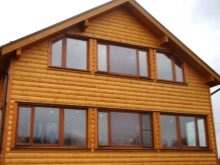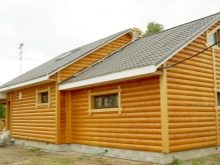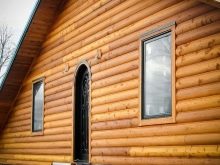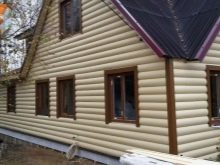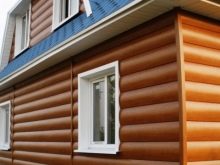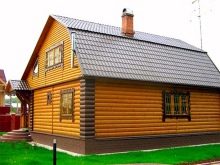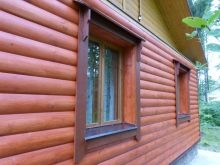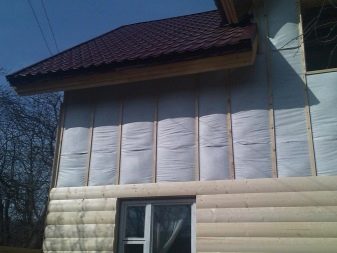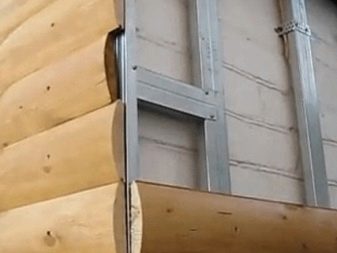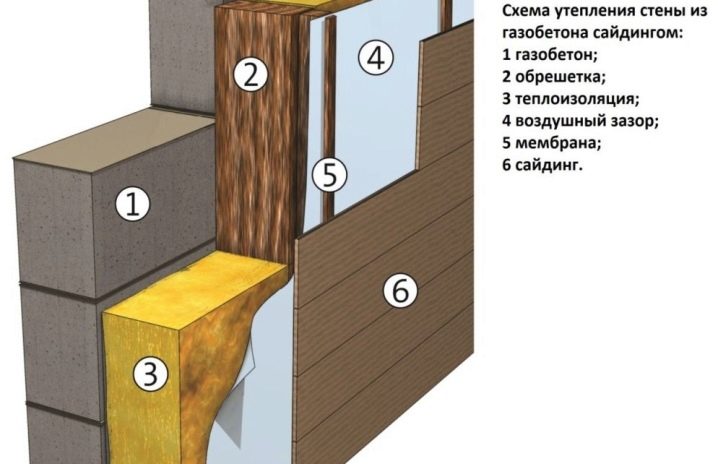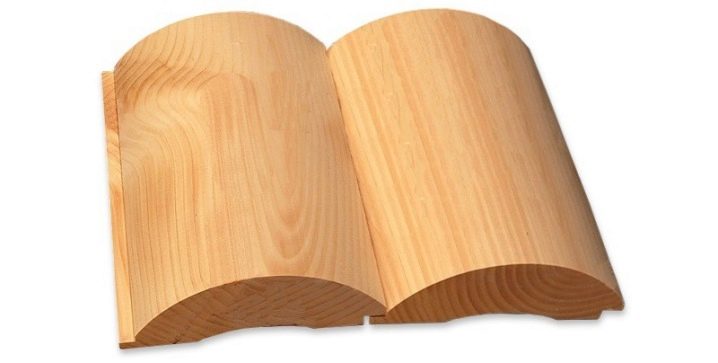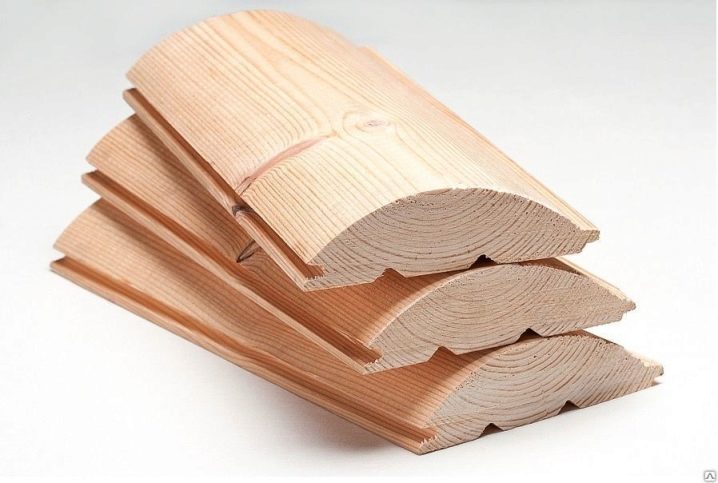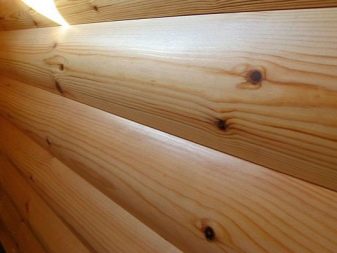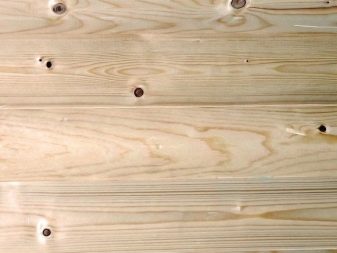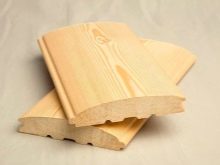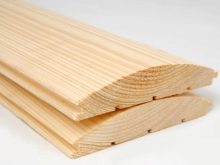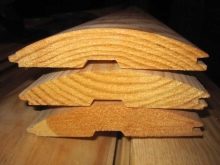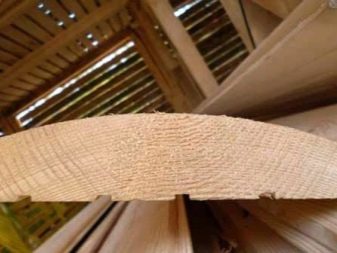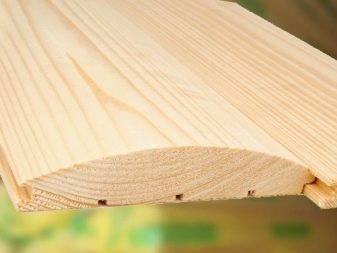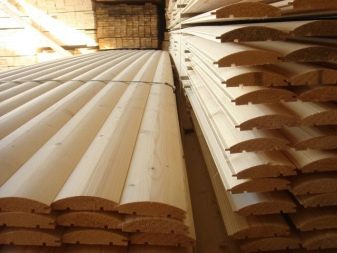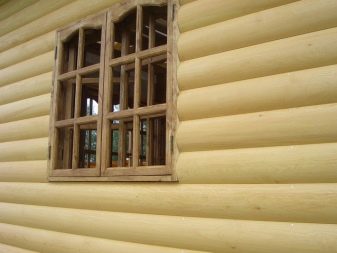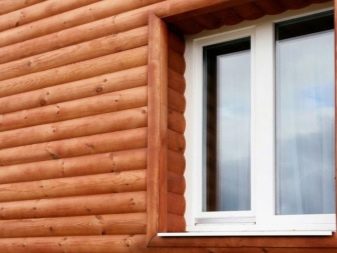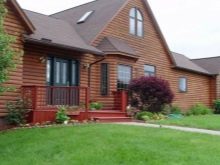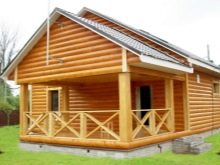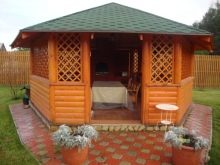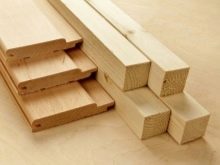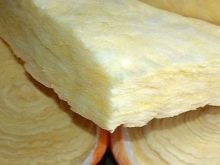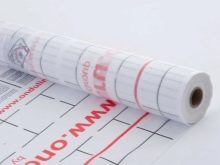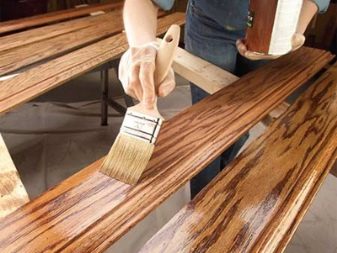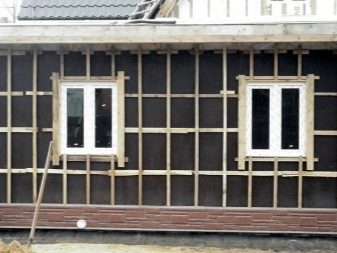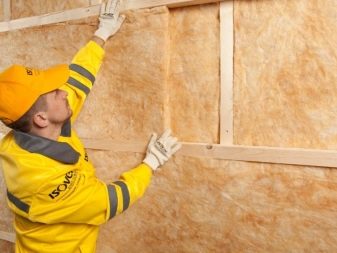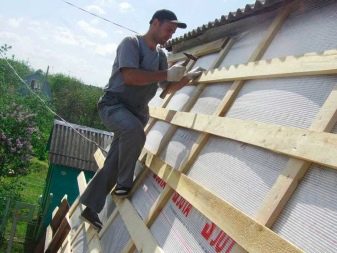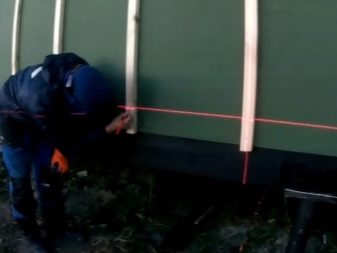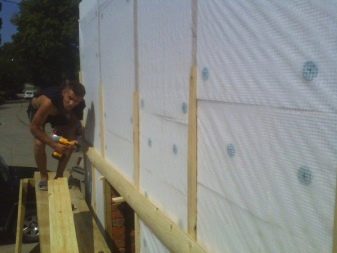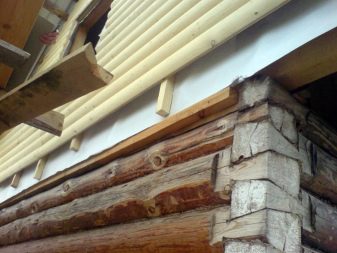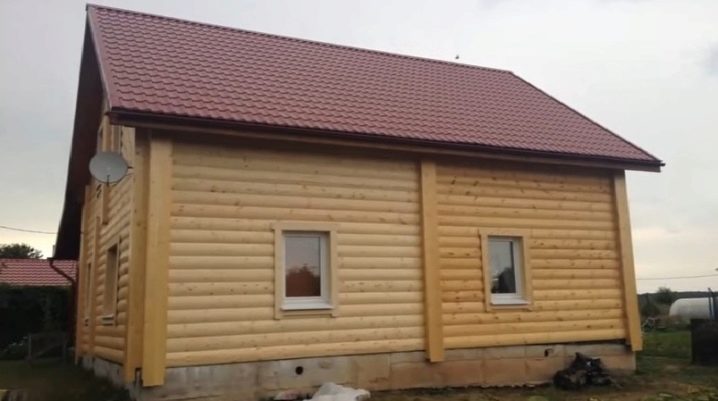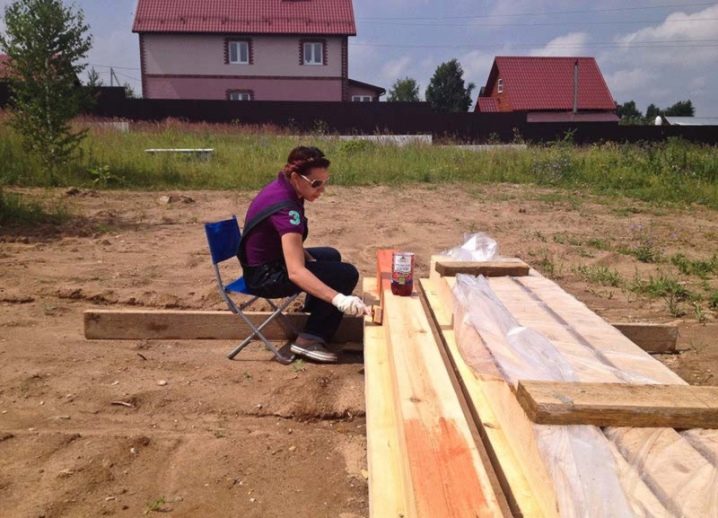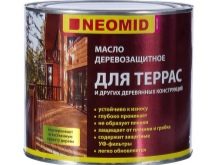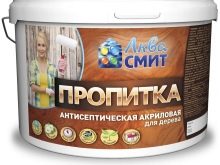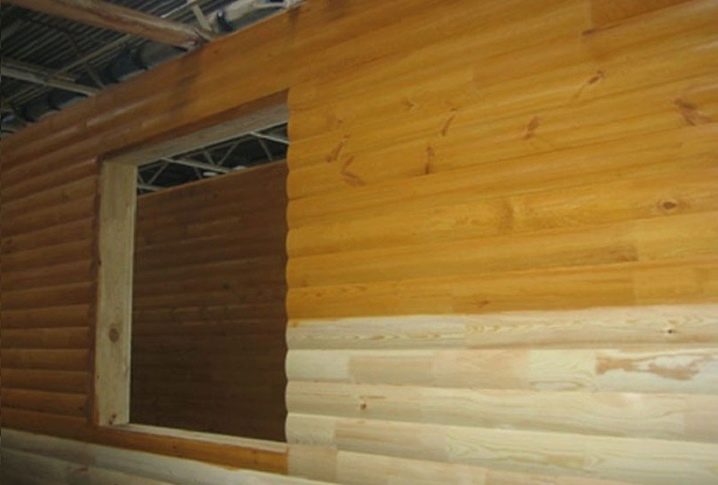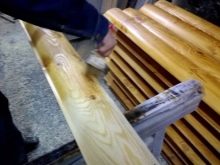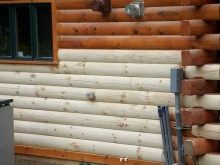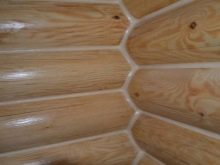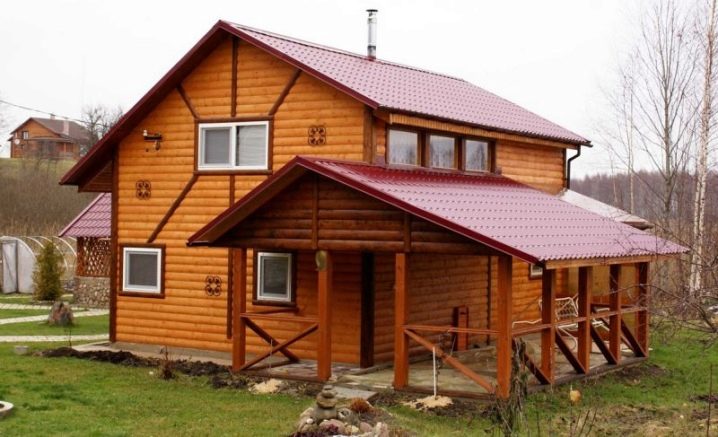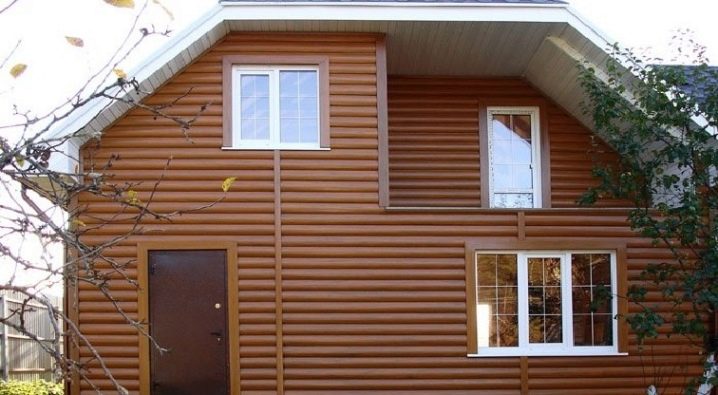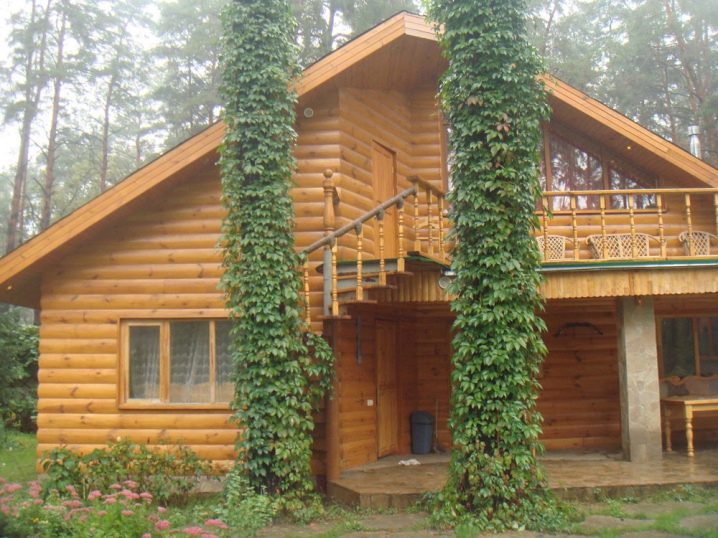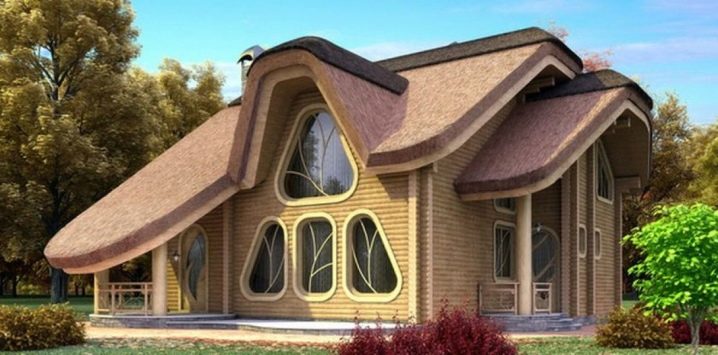Block house for the exterior of the house: the subtleties of the facade cladding

Block house - one of the types of lining. It is also used for finishing interiors and creating a ventilated facade. The traditional block house is a board with a convex outer side. Details connect with each other fastening "thorn-groove". The finished wall looks like it is made of timber.
Varieties of material
Elements of a block house can be not only wooden. Also produced metal and vinyl parts. Each type of finish has its own characteristics.
The main material for the lamellae are coniferous trees, as they are less susceptible to rotting. Four logs are produced from one log, which are kept in a drying chamber for two weeks.
The main advantage of the wooden facade finish - appearance. Wood imitation can fool the eye only at a distance. Near the impression will be completely different. In addition, wood retains heat for a long time. This property can be used to improve the microclimate in the house.
Details of the metal block house - curved steel plates, repeating the shape of one or two logs. A pattern imitating a wooden surface is applied to the outside. The inside is covered with a layer of primer and paint.
The facade of metal elements does not deteriorate from moisture and temperature fluctuations, resistant to fireIt is able to withstand severe shock and mechanical damage, and it is not exposed to insects. Thanks to this coverage will not have to update every 5-7 years.
It is worth considering that metal parts have a high thermal conductivity. They are very hot in the heat, and quickly give off heat in cold weather.
Vinyl block house is the cheapest substitute for wood.Like metal, it is not exposed to sunlight and biological factors. During a fire, it does not burn, but slowly melts, and at the same time it is not toxic. Vinyl parts will last at least 20 years without losing the original appearance.
However, this material is sensitive to temperature changes, which can trigger the appearance of mold and fungus. The surface of the vinyl block house is heterogeneous and does not always look like wood.
Special features
There are two types of plating: with insulation and without it.
Let us analyze the first, more popular option.
All design elements are equally important. If we neglect the vapor barrier or wind barrier, it will have to be repaired much more often. Layers are listed away from the wall.
Mount the block house in the same order:
- A layer of vapor barrier is needed to protect the insulation from moisture vapor from the side of the wall.
- The crate - the facade frame, creates a space between the wall and the block house. It is carried out from a bar with a section of 100 * 40 mm.
- Thermal insulation. The best suited rolled insulation, for example, mineral wool. The optimum layer thickness is 10 cm.
- The windscreen is attached to the crates bar.It protects the facade from the wind, and the insulation - from moisture contained in the air.
- Kontrobreshetka - wooden slats, to which the boards of the block house are attached. Have a section of 20 * 40 mm. An empty space is created between the windscreen film and the outer skin, which protects the inner surface of the boards from moisture.
- The outer layer is directly block house.
The design is quite light, does not create a load on the foundation. It is possible to equip such a facade not only during the construction of a new house, but also when repairing old buildings.
How to choose?
The quality of wooden elements can be determined by marking.
- E - extra class. Details have a perfectly smooth surface. The coating of such lamellas will be expensive, but it will also have to be updated less frequently.
- A - products with a well-padded base.without mechanical damage. Parts are suitable for both interior and exterior.
- B - boards from raw materials of low quality. On the surface there are knots, small holes, cracks.
- C - the base of the lamellae is poorly padded., there may be pieces of bark, cracks, falling knots and holes. Outside, the material of this quality will quickly deteriorate, and professionals recommend using it only for interior decoration.
Requirements and standards of different industries may vary significantly, so it is desirable to buy material from the same manufacturer. It is important to pay attention not only to the markings, but also to the appearance of the slats.
Here are some more tips to help you find a quality block house.
- Best for exterior trim larch. It keeps its original appearance for a long time and practically does not rot. Pine is a cheaper raw material, inferior to larch in quality and durability. A block house from spruce is good only for interiors.
- Professionals recommend using slats from 35 mm thick to finish the facades. The length of parts may be 2-6 m, width - from 15 cm. All elements must be the same size, and the number of joints - minimal.
- Boards of trees grown in the northern regions are more dense. This improves the remaining characteristics of the material.
- On high-quality lamellae there will be no mold, rot, cracks and falling out knots.
- Pay attention to the storage conditions: the goods should lie under a canopy on pallets or racks. Check the integrity of the packaging.
- Try to connect the parts.The spike should fit into the groove tight, but without much effort.
- Find out the moisture level of the slats and the dimensions of the grinding. The permissible value of the first indicator is up to 20%, the second is up to 3 mm in depth and up to 8 mm in width.
- It is good if the parts have undergone a protective treatment with biopirens and fire retardants. It makes them more resistant to external factors.
- Finishing will be more beautiful if the boards correspond to the scale of the house. On the facades of large houses, wide lamellas look better, and for smaller ones, narrow ones will do.
How to sheathe?
The block house can be used not only for decoration of a private house, but also gazebos or baths. The basis for such a facade can be a wall of any material: wood, brick, aerated concrete. It can be made the outer part of the frame construction.
A short list of required materials:
- bars for lathing and counter lattice;
- glass wool;
- vapor barrier and wind insulation film;
- nails with anti-corrosion coating for fastening panels;
- antiseptic (if wooden parts have not been processed).
Work on the installation design includes a number of stages.
- Training. It is necessary to stock up on all materials.If the blockhouse lamellas are not industrially processed, you will have to do it manually with antiseptics.
- Installation of vapor barrier. Fix the film from bottom to top so that the strips overlap each other by 10 cm. You can fix it with a staple. Then seal the seams with duct tape.
- Mounting battens. The distance between the bars should not exceed 60 cm. Around the door and window openings make additional rails - they will be useful when installing the counter grille. Easier to fasten the elements of the frame to the metal corners. Cuts on them allow you to install the elements strictly vertically.
- Work with insulation. Glass wool is laid tightly so that there is no gap between it and the crate. Condensate accumulates in them, and the presence of moisture does not have the best effect on wooden structures. And if moisture gets into glass wool, its efficiency will decrease. The front surface of the insulation is closed with a windscreen.
There is an algorithm for the installation of the wall paneling:
- On the crate, reinforce the laths of the counter-lattice.
- Beat off the line of the bottom row. A laser or water level will definitely help.
- Cut the protruding ends that extend beyond the line.
- Fix the first board along the line. Position it with a spike up - then the moisture will not be collected in the grooves. Nails are driven from above and below, into a thorn and into a groove. This should be done carefully so that there are no chips.
- Continue stacking the second and next rows in the same way.
If the length of the wall is greater than the length of the block house.
- Arrange the joints on the same vertical. Then, top the board with a width of 10-15 mm and a thickness of 20 mm. The same boards can trim the corners, slopes and trim. This method is simpler, but the finish looks unprofessional.
- Joints are staggered. In this case, the cuts should be perfectly matched to each other, and the length of each board should be selected separately. The facade will look much more attractive.
In the next video you will see how to sheathe the facade of the house with a block house with insulation.
How to paint?
Wood is an aesthetically attractive material that is susceptible to various influences. It may be affected by moisture, temperature changes in winter, ultraviolet rays and insects. Elements of a block house from natural raw materials are no exception. Impregnations and protective paintwork will help extend the life of the wooden facade. A more expensive version of the block house is being processed in autoclaves.The elements of the coating are impregnated with compounds that protect the wood from fire, decay and the destructive action of other factors.
Those who bought the raw parts should improve their properties on their own. It is necessary to do this before installation. It is advisable to handle and strips, and the crate, and the base. For this fit impregnation and stain.
Impregnation does not change the appearance of wood. All compositions can be divided into three groups:
- Water soluble acrylics are used for untreated wood. Good for interior decoration, as they do not have an unpleasant smell.
- Alkyd are made on the basis of white spirit and alkyd resins. They create a durable coating, but have a serious drawback - a sharp smell. Used only for facade work.
- Oil made on the basis of natural oils, often flax. The coating is absorbed and dries for a long time, but it turns out resistant. But it is incompatible with some colors.
Wood stains change a shade of a tree towards dark tones. It does not form a smooth layer or film on the surface. There are also colorless, they perform only protective functions.Available in water-based formulations, as well as on the basis of alcohol, solvents and wax.
Decorative coating can emphasize the natural structure of the tree or change it in accordance with the intention of the owners. In the first case it is worth choosing a transparent varnish or azure. If the surface of the parts is not ideal, the paint will help to hide some of the flaws.
For the decorative decoration of the block house, you can use materials, given their features.
- Varnishes create a transparent or translucent film on the surface.
- Azure have protective properties of impregnations and at the same time create a thin waterproof layer on the surface. They are glossy and matte, transparent and tinted. Alkidnouretanovye azure makes wood more resistant to mechanical damage.
- Paints - glossy, matte and semi-matte. For outdoor decoration is better to choose an oil, not a water-based one.
- Wax - a traditional matte finish. It is important to remember that it is no longer possible to apply varnish or paint over it.
Before painting the wall of the house, sheathed with a block house, it is cleaned from dust or old coating. It is desirable to paint new parts before installation.Before applying the paint, wood is treated with a primer. It will improve the adhesion of the enamel to the surface. To work on a large area, masters advise using a roller and brush on hard-to-reach areas with a brush.
Beautiful lining examples
A fairly common project of the house, sheathed block-house. The building looks respectable, despite its modest size.
Metal block house is not suitable for imitation of a wooden wall. At the same time, he creates an interesting surface texture that can be used in simple but interesting projects. The house in the photo would be unremarkable if it were not for the "highlight" - the recessed part of the facade and the line with which the roof delineates the wall.
Here the building fits well into the landscape. Trees around and trimmed with lamellas create a cozy atmosphere for residents of the house.
Here is another example of successful transformation of an ordinary country house into an original building. It is enough to change the shape of the windows and the roof. Recent photos show that you should not be afraid that a house with a block-house finish will be indistinguishable from others. If you add interesting details to the project and associate it with the environment, the building will be unique.

